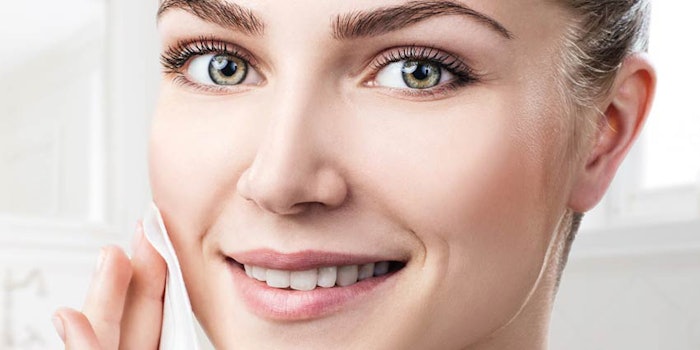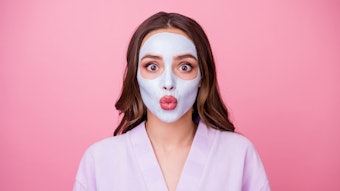
Cleansing the face is an important step in any regimen for healthy skin, and it is important to the spa not only as part of most treatments, but also as part of home care programs. Facial cleansing primarily removes dirt and epithelial debris from the skin’s surface but can be so much more. Cleansing helps maintain skin barrier function1 and assists routines designed for acne, anti-aging and men’s skin care. This article will discuss the latest in cleansing technology, reviewing some innovative formulation concepts. Before discussing characteristics of more complex cleansers, it is necessary to understand how cleansers work.
Soaps, Sebum and Dirt
Soaps, a group of products including cleansers, are agents with the primary purpose of removing dirt from skin. Some dirt is oily in itself, but all dirt that has accumulated on skin is oily due to its combination with sebum. Sebum is an oily substance containing many different lipids (oils). The lipids of sebum are designed to help support the skin’s acid mantle and maintain its pH of about 5.5, fortify the skin barrier, provide moisturization and help make the skin impermeable to water. Sebum is a key player in the skin’s job of “keeping things out and keeping things in.” Important fats composing a healthy skin barrier include ceramides, cholesterol and free fatty acids.2 Since the skin’s surface is in itself oily, oily dirt sticks to it and is difficult to remove without the special help of soaps or cleansers.
Accumulated dirt mixed with sebum would naturally stick to skin and remain there. This material also contains cells that have been shed in the natural process of exfoliation. Soaps and cleansers must remove dirt and epithelial debris and wash it away to clean the skin. Cleansers consist of molecules with a lipid soluble end that dissolves in oil and another water soluble end that dissolves in water. These two ends of the molecule are called lipophilic (lipid- or oil-loving) and hydrophilic (water-loving). The oil-loving portion of this molecule attracts and dissolves the oily dirt on the skin surface. When water is added during the rinsing process, the water combines with the water-loving end of the molecule and the dirt is washed away down the drain. Inadequate addition of water will allow a residue of dirt to remain on the skin. All cleansers or soaps work in this same way.
Activating Skin Cleansers
Many modern cosmeceutical cleansers contain actives, or ingredients with a functional benefit to skin. Examples of actives include antioxidants, exfoliation agents, wound healers and vitamins.
It is common for antioxidants to be added to cleansers for additional skin benefit. Exfoliating agents, including alpha hydroxy acids (AHAs), beta hydroxy acids (BHAs) and/or enzyme exfoliators may also be added to further remove devitalized cells of the stratum corneum.
Gentle Cleansing
Some cleansers are gentle to skin while others are more aggressive. Harsh cleansers are usually less expensive to make but can result in sensitivity and inflammation. Gentle or mild cleansers are used to avoid secondary skin inflammation, redness, flaking, irritation, tightness, itching and discomfort.
Skin inflammation and sensitivity result when the skin barrier is disrupted by a cleanser removing too many barrier lipids. Free fatty acids are especially vulnerable to removal by cleansers (saponification agents). Mild cleansers remove few or even no barrier lipids, thus leaving the skin barrier function intact.1 The molecular structure of mild cleansers differs from that of harsh cleansers in the length of the molecule and other factors.
Cleansing Balms/Oils
Cleansing balms and cleansing oils have a high lipid content designed to preserve or replenish the skin barrier. With a consistency ranging from an oil-rich lotion to greasy, they could be temporarily useful in winter or dry environments but an inadvisable year-round choice. They may contain lipids very different from those found normally in the skin barrier, leaving an un-natural lipid residue that can interfere with makeup application and contribute to congested pores and acne breakouts. Dry skin types often initially like balms and oils; however, it is important to include adequate exfoliation, nutrition and thorough cleansing in the comprehensive skin regime.
These high-lipid cleansers may dissolve makeup well but not remove it effectively from the skin’s surface because adequate rinsing is not possible.
Cleansing Wipes
The market for wipes and other cleansers not requiring water continues to grow.3 However, a cleanser without the addition of any water will dissolve the dirt in the oily portion of the soap molecule only and remove it onto the wipe. Therefore, the dirt will be incompletely removed from the skin if water is not used to adequately rinse the dirt away. These time-saving cleansers, therefore, require a double cleanse.
“Sulfate-free” Cleansers
Since sulfate cleansers are potentially irritating, especially in high concentrations, “sulfate-free” cleansers have gained popularity. These cleansers contain sulfonates, a term that sounds very similar to “sulfate” but indicates a chemically different molecule. Sulfonate cleansers in the group sulfonated alkyl polyglucosides (SAPGs) may be substituted for sulfate cleansers. SAPGs are mild, lack toxicity risk and cleanse adequately.4
Some cleansers containing sulfates are safe. The consumer concerns about toxicity, especially related to baby cleansers, centered around government findings that some sulfate cleansers could be contaminated with 1,4-dioxane above the safe level. Dioxanes are potential carcinogens (cancer causing), and some cleaning products were found to contain these above the safe level of 20 ppm.5
Micellar Waters
Micellar waters are a type of cleanser that places the saponification molecule into a circular configuration. See Lipid Micelle for this structural configuration.
These cleansers are composed mostly of water in which tiny micelles (small particles) are suspended with saponification agents arranged with their lipid-rich (lipophilic) ends inside and water-loving ends pointed outward. The interior lipid-loving part of the molecule absorbs oily dirt and suspends it in the water-rich environment. Surface dirt and epithelial debris can then be wiped off or rinsed off with very little water. However, micellar waters are sometimes inefficient at removing dirt and makeup, necessitating further rinsing or a “double cleanse.” Due to their higher oil content, micellar waters may also increase oiliness and worsen acne.
Antibacterial Cleansers
Government studies have shown antibacterial cleansers to be no more effective against bacteria than plain soap and water.
Another possible problem with antibacterial soaps is that they may disrupt the normal bacterial balance of the skin. More and more evidence substantiates that this symbiotic relationship of human skin and the microorganisms living on it is important for skin health and decreasing many types of skin diseases related to infectious processes, such as acne and rosacea.6-7
What to Recommend?
In the treatment room and at home, adequate cleansing and removal of dirt and epithelial debris is a must. Cleansing should be done with large amounts of water to adequately cleanse. This is especially true for exfoliating procedures during which devitalized stratum corneum cells are removed.
There may be special situations in which specialized cleansers using little water are advantageous, including outings, such as camping or sports activities, where minimal clean water may be available. Other than these occasional exceptions, skin health is best served by adequate removal of dirt and debris. This most often requires adequate rinsing off of the cleanser.
REFERENCES
- K Steventon, Facial cleansing with mild surfactants, Cosm and Toil Sep 5 (2014)
- C Phuong and HI Maibach, Taking it off: Cosmetics removal is essentially decontamination, Cosm and Toil (2016)
- D Utroske, Trends from numerous beauty categories influences wipes market, EU newsletter: Breaking news on cosmetics formulations and packaging in North America Jun 9. (2016)
- RJ Coots, Sodium laurylglucoside hydroxypropyl sulfonate for sulfate-free formulations, Cosm and Toil 126(4) 274 (2011)
- www.organicconsumers.org/articles/article 12797.cfm
- www.cosmeticsandtoiletries.com/research/biology/Connecting-the-Dots-Between-Microbes-367821901.html
- www.aad.org/media/news-releases/could-probiotics-be-the-next-big-thing-in-acne-and-rosacea-treatments (Websites accessed Aug 9, 2017












